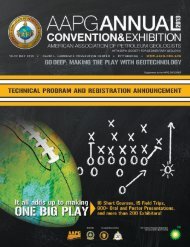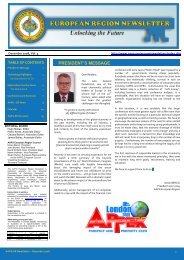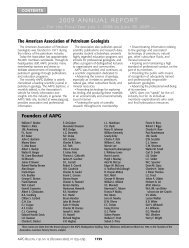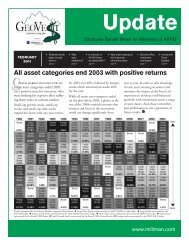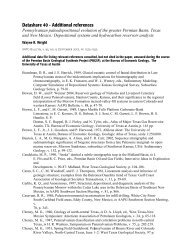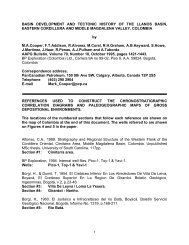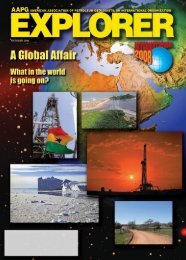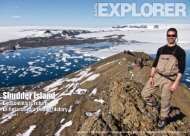EXPLORER - American Association of Petroleum Geologists
EXPLORER - American Association of Petroleum Geologists
EXPLORER - American Association of Petroleum Geologists
You also want an ePaper? Increase the reach of your titles
YUMPU automatically turns print PDFs into web optimized ePapers that Google loves.
<strong>EXPLORER</strong>Favorable regulationsEXPLORATIONINNOVATIONSNorway Proves to Be Nice for UAV TechnologyBy LOUISE S. DURHAM, <strong>EXPLORER</strong> CorrespondentDrones, i.e. unmanned aerial vehicles(UAVs), are not welcome justanywhere.Their reputation as stealth machinesperforming unwelcome activities tends toovershadow the good side <strong>of</strong> these roboticconveyances.Norway is among the countries withrelatively less stringent regulations regardingUAV flights.It’s home base for a group <strong>of</strong>researchers using some excitingapplications <strong>of</strong> varied cutting edgetechnology, including the drone.BUCKLEYThe Virtual Outcrop Geology (VOG)research group, based in the Centre forIntegrated <strong>Petroleum</strong> Research (CIPR)“We help improve knowledgeso that new and existing fieldscan be exploited to a higherpotential.”in Bergen, is drawing attention for itsinvolvement in using an array <strong>of</strong> geospatialtechnologies – including laser scanning,image processing and the UAV – to create3-D virtual models <strong>of</strong> outcrops <strong>of</strong> geologicformation.The UAV technology can take on asignificant role in acquiring needed data ininaccessible areas, which a drone <strong>of</strong>ten canreach much faster than a pricier helicopter“The virtual models <strong>of</strong> the outcrops canbe used by the geologists to gain a deeperunderstanding <strong>of</strong> geological features andtheir impact on subsurface reservoirs,” saidSimon Buckley, CIPR senior researcher andproject leader in the VOG group.The VOG group was formed in 2004with the goal to expand the quantitativeapplication <strong>of</strong> outcrops in reservoirs.“The main aim <strong>of</strong> the VOG techniqueis to obtain high resolution and accurategeometric information that can be used as aframework for interpretations,” he said.“Ultimately, we don’t do exploration,”Buckley emphasized. “We help improveknowledge so that new and existing fieldscan be exploited to a higher potential.”Precisely AccurateHe noted that over the past 10 years theVOG has acquired considerable expertiseusing 3-D laser scanning to scan surfaceswithin a centimeter <strong>of</strong> accuracy.“The main contribution is the highresolution and precision,” he noted. “Thisallows the geometry <strong>of</strong> geological featuresto be recorded and measured to anincreasingly high degree, which can then beused for reservoir modeling, for example.“In fact, a common use <strong>of</strong> the virtualoutcrop model is to digitize key surfacesthat are then exported to a reservoirmodeling system and used to buildgeocellular models.“Building geocellular models fromoutcrops creates a bridge between thesubsurface and the outcrop analog,”Buckley emphasized. “The modelsprovide an improved understanding <strong>of</strong> thestratigraphic architecture and can be usedto simulate fluid flow in the analog.“They also can provide a focal point fortraining and field trips,” he added.Assets and Challenges18 NOVEMBER 2013 WWW.AAPG.ORGThe specially designed, camera-equippeddrone piloted by the research team featureseight rotors displayed on spokes emanatingfrom the central body. The accoutermentmeasures only a few feet across and tips thescales at just a few pounds.It affords a stable platform for the camerasensors, being easily and quickly guidedinto position over the target area whilecontrolled by an operator nearby on theground.“UAVs are proliferating rapidly intomany applications,” Buckley said. “We sawthe advancements in both the platformtechnology and the processing methodshad reached the point where we couldadapt them into our existing workflows.“Advantages <strong>of</strong> the UAV are that itprovides optimum camera positions for takingimages, is fast to use and is cost-effective inrelation to lidar equipment,” he noted.“Challenges are perhaps mostlyrelated to logistics and operation,” hesaid. “User training is required, weatherconditions must be suitable (



